|
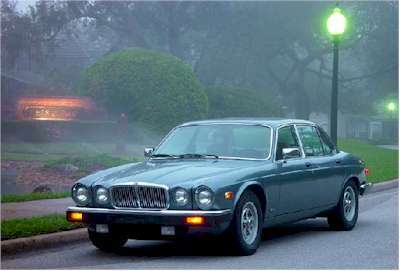 1986 XJ6 - picture Robert Phelps III
1986 XJ6 - picture Robert Phelps III |
1968... a year usually remembered for the social unrest that shook Europe
but for Jaguar enthusiasts, it's the year the XJ6 shook the automotive
world. A ground breaking saloon which would enjoy unparalleled success
for the following 20 years (almost 25 if you consider that the V12 version
remained in production until 1992...). The XJ6 is also significant being
the last new Jaguar launched under the leadership of the company's founder,
Sir William Lyons.
Back in 1968, the all new XJ6 had no competition as it set new standards
of luxury, elegance and performance. It was drastically different from
Jaguar's other offerings, the big Mark X or the highly successful smaller
Mark 2 which where all based on 1950s designs. It was also light years
away from the company previous generation saloon, the Mark IX. In contrast,
the XJ6 was a monocoque design instead of a body on frame construction
and while a certain family resemblance could be found with the Mark X
/ 420, the slim elegant lines stood out. Although the 420G would continue
on for a while in limited numbers, Sir William Lyons vision of the new
XJ replacing all of the company's saloon worked and would in fact support
the company until the end of the century...
Mechanically it was also breaking new grounds for saloons with its rear
independent suspension nearly identical to the one found on the E-type.
This not only provided superior handling but also reduced noise and vibration
thanks to its rubber mounts. The engine was the proven and powerful 4.2
liters XK inline 6 cylinder developing 175hp and 225lb/ft of torque, giving
the car a solid performance edge over its competition. As with previous
Jaguar models, price was extremely competitive at just over UKP 2000 despite
the luxurious appointments of its interior : comfortable leather seats
and plenty of wood, just like a Jaguar should be ! The dash and instrumentation
was very conservative and similar to what Jaguar drivers were used to
in the Mark 2, Mark X and even the E-type : twin large primary instrument
( tach and speedometer), secondary instruments in a center panel immediately
above a row of rocker switches.
Victim of its own success, early deliveries were slow as Jaguar's attempt
to meet the demand and were hampered by delays in body manufacturing;
the first cars were actually suffering from quality control problems.
Despite these, the XJ6 was so superior to its competition than buyers
were willing to wait and could even resell their just delivered XJ6s at
a profit should they want to. As result of the sleek lines, interior space
(especially in the back) was really the only deficiency of the new XJ6,
something that will be addressed by a longer wheelbase model, although
not until 1972. In some markets where taxes favored smaller engine, Jaguar
offered a 2.8 Litre version of its XK engine at the expense of performance
(140hp) but that version was not as successful facing stiff competition
from BMW.
1972 would be the year Jaguar launched the XJ12, once again setting new
standards in motoring by combining the elegant lines and luxury of the
XJ6 with the smoothness and power of its new V12 engine, introduced a
year before in the E-type. Using the same 4 Strombergs carburettors found
in the E-type (fuel injection would not come to the V12 until the XJS
in 1975), it developed 255hp and a whopping 300lb/ft of torque... The
XJ12 is Sir William Lyons final achievement before his retirement that
same year and the numbers speak for themselves: faster production four
seater in the world at 140 mph and 0-60 times of under 7.5 seconds. The
XJ12 had no match even though Jaguar's competition was starting to catch
up, a task made even tougher with the introduction of the Series 2 XJ
in 1973.
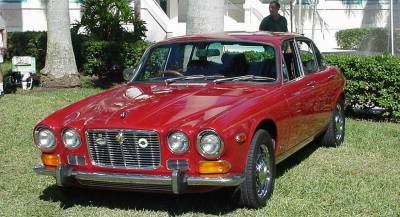
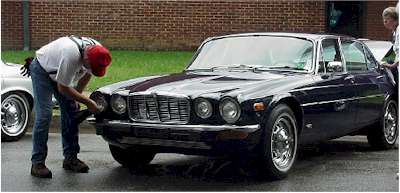
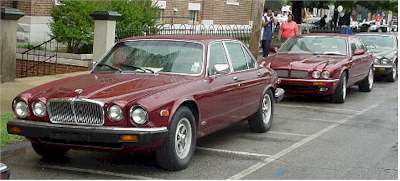
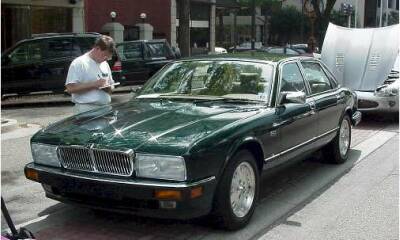 From the top, XJ6 ... 1 - 2 - 3 - 40!
Four evolutions of the XJ Saloon
From the top, XJ6 ... 1 - 2 - 3 - 40!
Four evolutions of the XJ Saloon
1973 Series 1 XJ6 (William Sutter, SFJC)
1974 Series 2 (Scott and Linda Young, JC Tulsa)
Series 3 parked in front of a late model XJR
1994 XJ40 (Bill and Margaret Bingham, Carolina JC)
|
The most obvious change in the Series 2 came at the front where new bumper
height requirements forced Jaguar to redesign the grille and move the
signals / markers below the bumper, overall an even sleeker and more refined
design. The instrument panel was also modernized with the secondary gauges
moved in front of the driver around the primary instruments and the rocker
switches dropped in favor of column mounted stalks.
As the Series 2 was being introduced, Jaguar unveiled what will become
one of the rarest car in the company's modern history : the XJ Coupe b(badged
XJ6C or XJ12C). Built on a short wheelbase XJ, the two door coupe was
built without central pillars for a striking look, particularly with the
windows rolled down. Built only between 1974 and 1977, this highly desirable
Jaguar is now becoming a true collector especially in V12 form. About
10 000 coupes were built, and fewer than 2500 were V12. While the lack
of central pillar somewhat compromised body rigidity, it is a really a
more sporty version of the saloon and handles fairly well. All cars were
delivered with a vinyl covered roof giving them an unusual look for a
Jaguar.
The next major revision to the XJ saloon came in 1979 when Jaguar called
on Italian design house Pininfarina but again restyling was kept fairly
subtle. Alteration to the roofline, now flatter, changes to the rake of
the windshield and changes to tail lights, wheels and trim. The new front
grille was changed from horizontal to vertical slats.
The US model was still powered by the 4.2 litre XK engine, fuel injected
since 1978. Again, early deliveries suffered from quality control issues,
especially paint, but the updated engine, with fuel injection, larger
intake valve and management system was once again setting new standards,
developing over 200hp.
US market XJ6 were always fully equipped but for those desiring even
more luxury, the Vanden Plas (named after the renowned coach builder)
provided an upgraded interior.
Despite the investment, the new XJ6 was really just a stop gap, final
evolution before the arrival of the next generation saloon. This however
would take much longer than anticipated, in part due to the financial
problems faced by Jaguar and parent company British Leyland in the early
80s keeping the XJ6 in the showrooms for most of the 80s.
Finally after years of development and postponements, in 1986 Jaguar
unveiled its next generation saloon, still badged XJ6 but also known under
its code name XJ40. This was not just a face lift or redesign but truly
an all new car. On the outside, styling was radically different with rectangular
design which could be called boxy if it wasn't for the still elegant tapered
lines. Gone where the trademark twin petrol tanks / fillers and, depending
on market and specification, the XJ40 featured attractive rectangular
headlights.
Under the bonnet, an inline 6 was still powering the car but it was an
all new engine: the fuel injected AJ6 launched a couple of years earlier
in the XJS. With dual overhead cams and 4 valves per cylinder, the 3.6
Litre engine delivered 221 hp; more power, better fuel efficiency and
less emission than the venerable XK engine could. The suspension was revised,
with conventional outboard brakes in the rear and a new self leveling
hydraulic system. The interior was all new, with a completely revised
and modern dash featuring what would become a trade mark for Jaguar, the
J-Gate shifter. The car’s tapered lines still meant that passenger
and luggage space was still lacking.
Once again, the base model XJ40 was sold including all options in the
US and additional models were offered like the Vanden Plas, Majestic and
Sovereign; all mechanically identical with slight trim changes.
During the XJ40 development phase, Jaguar designers feared that British
Leyland would impose use of the Rover V8 engine in the new saloon and
made sure that the car was designed in such a way that a V engine could
not be fitted. As a result, there was no way to fit the V12 without extensive
modification and with the more traditional looking series 3 XJ still in
demand, the series 3 XJ12 would remain in production and offered in parallel
to the new XJ40. It would take until 1992 for the XJ40 body shell to be
redesigned to accept the V12...
After Ford purchase of the company in 1989, a massive investment program
was launched to improve quality. While Jaguars were always a step ahead
of competition in the styling, performance and comfort department, they
were usually behind in reliability... Ford's financial resources and technology
meant that improving reliability and engineering was possible and the
XJ40 benefited from this. By the final two years of its production, in
1993 and 1994, the XJ40 had become a well built and reliable Jaguar..
At last!
Buying an XJ
There is little doubt that the XJ is one of the most recognizable Jaguar
on the road today even though the last series 3 XJ or XJ40 were sold some
15 and 9 years ago. This is because during it's lifespan, the XJ saloon
has not changed drastically and has always remained faithful to its original
design. Even the Xj40's successor, the X300, shares a lot of styling clues
with the series 3 like the elegant tapered lines and the quad round headlights
flowing into the bonnet. Looking at the future, the upcoming X350 is again
only a styling evolution of the original timeless design, making the early
cars still very attractive.
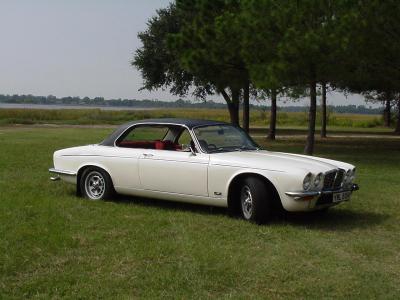 Rarest XJ of all, the XJ12 Coupe
Rarest XJ of all, the XJ12 Coupe |
The Series 1 is now truly a classic saloon, with 1960s technology (and
simplicity) and they are, like the series 2, much more rare than the series
3. Yet, because it was so ahead of its time, it doesn't look as dated
as other cars of this era and still performs remarkably well on modern
roads. The V12 particularly is a very good performer if one is willing
to accept fuel consumption that would make an SUV owner feel like an environmentalist...
Simplicity was still the rule back then and although some emission control
devices had started invading engine bays in the late 60s, catalytic converters,
oxygen sensors and engine management system were still years away. Carburetted
cars featured Strombergs carburetors which when properly set up are just
as reliable as anything else.
Among the series 2 XJs, the coupes are highly desirable because of their
short production run (3 years). They blend the traditional lines of the
XJ with the unique lack of central pillar and longer doors. The low production
numbers means that few of these cars have survived and they are now becoming
rare.
Series 3 XJ6s are still found on the road as daily drivers and don't
have the collectibility of the earlier saloons. Because they still fall
in the "used car" segment of the market, some can be seen in
various states of begging for some TLC and can be a sad sight. These are
15 to 20 year old cars which can be bought for very little money, by owners
who can't necessarily spend what is needed. Series 3 XJ6 can be found
in classifieds for $ 3000 or less and at that price, don't expect a car
that has received thousand of dollars in maintenance... The key here is
to be patient and wait to find for the best car within your budget.
The XJ40, built from 1987 till 1994, is probably one of the best buys
on a used car lot these days especially the later models loaded with power
everything, dual airbags, cruise control, ABS, good sound system and more.
If you consider that for about $ 10 000 you get a luxury car with the
best leather and wood to pamper you, timeless styling and excellent performance,
what more could you want? a cheap Korean import econo box ? Again, well
maintained and cared for, an XJ40 doesn't look like it was designed almost
20 years ago...
As for most used cars, but especially Jaguars, the most critical part
of the purchase is an inspection by someone who knows these cars. While
not terribly complicated, they are some pitfalls and knowing what to look
is important.
Rust is the main concern when it comes to the XJ6 series 1 thru 3...
what's new?. XJ40s are less prone to rust problems since they obviously
benefited from advances in paint and rust protection but some spots like
boot lids, doors, etc.. can be source of problems. In addition to the
obvious spots like floors, lower doors, the classic XJ6 is prone to rust
below the windshield and rear window and while the repairs are terribly
costly, if left unchecked damage can become extensive. Yes, there are
many components hidden behind the dash that don't react too well to water...
Rust can be expensive to repair and never cures itself, keep that in mind
when considering an XJ6 and don’t hesitate to pass on an apparent
good buy…
Engine and transmissions are rarely an issue on Jaguars and the engines
powering the XJ6 or XJ12 are nearly bulletproof. The only series of engine
that suffered from reliability issues was the early 2.8 liter XK engine
which was not available in the US. The V12s are more expensive to maintain
as they obviously have more of everything… spark plugs, heads, pistons,
valves, etc… and less space to work around. They also do not handle
overheating too well so any V12 with a history of running hot should be
considered suspect. Otherwise, both the XK engine used in the series 1
thru 3 and the AJ6 found in the XJ40 are solid and reliable although is
not uncommon for AJ6 engine to need head gasket replacement around 100k
miles.
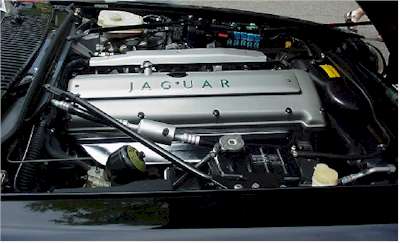
Jaguar AJ6 engine in a 1994 XJ40 |
And this is really the irony of Jaguars for sale with American V8 engines!
A number of series XJs have been “lumped” with V8s supposedly
to solve reliability problems when in fact the only thing to fix should
have been the mechanic’s own ignorance… The engine is rarely
the problem but the accessories, wiring, etc… are; and pushing a
cheap V8 on an unsuspecting customer is easier… Lumped Jaguars are
worth next to nothing because of the usually poor quality conversion and
loss of originality and character.. The V12 or XK engines are very much
the part of the car’s soul.
Early XJ6 and XJ12 used Borg Warner automatic transmission which work
well and rarely give problems. Later V12 cars used GM transmissions, also
reliable as were the ZF used on the XJ40. Transmission technology has
gone a long way over the 25 years of the XJ6/XJ40 series and units have
become more refined, adding a gear or two and sports mode on the later
models.
Another thing to look out for are modifications made to the cars, especially
to the electrical system. By pass wiring, extra switches and cheap aftermarket
security system can become a major source of problems especially as the
XJ became more complicated over the years.
Finally, one area where things became significantly more complicated
is the climate control system and when checking out a car, do not assume
that a malfunctioning climate control is just a minor accessories. It
can be costly to take apart the dash if the problem turns out to be more
than an A/C recharge!
Driving and maintaining an XJ
Jaguars have always offered good performance and the XJ6 is no exception.
Despite the car’s size and weight, the straight 6 engine provide
plenty of power making the big cats a perfect choice for highway cruising.
Of course, in the performance department the V12 is king with plenty of
power and low end torque for passing and accelerating. It is also a very
smooth engine, perfectly at home in a Jaguar saloon. On the downside,
its fuel consumption is an issue in places where gas is expensive. The
later versions of the V12 benefitted greatly from changes made to the
engine design and from electronic management system; they are far more
economical to run.
Ride quality is also something Jaguar saloons are known for and the XJ
shines there as well; soft and comfortable yet capable of good handling
when the driver is in a spirited mood.
One of the most common complaint regarding the XJ saloon is lack of interior
and boot space. Ever since the early days of Jaguar, the lines of the
car and its elegance was crucial to Sir William Lyons who would not sacrifice
them for just more space. Until very recently this remained true and Jaguar
owner do pay a price, a small one, for those elegant tapered lines : limited
passenger and luggage space. If you need to go on long family trips with
plenty of luggage, you might have problems fitting everything! Interior
space is adequate, although a bit limited in the back in short wheel base
cars but the quality of the cabin appointments more than make up for this.
Unfortunately, these wonderful saloons are getting older and will need
a little more attention than a new one so you'd better plan on spending
some money on maintenance.... The good news is that despite their bad
reliability reputation, neither the original XJ or the XJ40 will be the
troublesome money pit some say they are. Parts are easy to get and not
necessarily expensive; there are also a number companies who specialize
in used parts, a good option when on a budget.
A good service manual will let most owners do a lot of maintenance and
if really not “tool inclined”, there are plenty of independent
specialists who can service the car for a reasonable cost. A word of advice
here, these are not cars you want to get serviced at most official dealers
but you don't want to let Joe-the-corner-import-mechanic put his paws
under the bonnet either. Finding a good independent Jaguar specialist
you can trust is key, and if you do, you can have the best both world...
a luxury Jaguar for the price of cheap new econo box.
|

